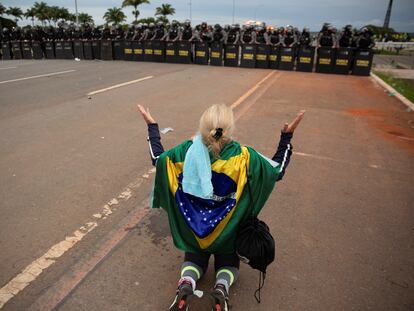The three hours that shook the foundations of Brazil’s democracy
A timeline of how a Bolsonaro march turned into a violent mob that invaded Congress, the Supreme Court and the presidential palace

For many of the protesters who took part in the assault on the heart of Brazil’s democracy, Sunday in Brasília began with a five-mile walk from the Army headquarters – where demonstrators have been camped for months – to the Praça dos Três Poderes (Three Powers Square), where Planalto Palace, the Supreme Court and Congress are located. The three buildings form the points of an equilateral triangle devised by architect Óscar Niemeyer to represent the executive, the judiciary and the legislative branches of government. On Sunday, they became collateral damage in a march that shook the foundations of Brazil’s democracy.
This is a timeline of what happened, based on reporting by the Brazilian newspaper O Globo.
Saturday. Brazil’s new justice minister, former judge Flávio Dino, notifies the governor of the Federal District, Ibaneis Rocha, an ally of former president Jair Bolsonaro, that a new group of Bolsonaro supporters is arriving in Brasília on chartered buses from other cities. The ABIN Secret Service agency warns various security organizations that there is a risk that the protesters will storm public buildings in the next few hours.
Sunday, 1pm in Brasília: Radical Bolsonaro supporters, who had been calling on the military to stage a coup against President Luiz Inácio Lula da Silva, leave the camp outside the Army headquarters in Brasília and walk on foot to the Three Powers Square. The protesters, who believe the leftist leader stole the 2022 presidential election, are escorted by military police. The march begins exactly one week after Lula da Silva, popularly known as Lula, was sworn into office.
In an audio message released by local newspaper Folha de S.Paulo, Fernando de Sousa Oliveira, the acting state secretary for public security of the Federal District, tells Governor Rocha that the protesters, with whom he has negotiated, are advancing peacefully “for now.” In hindsight, this “for now” is striking. Oliveira adds that 150 buses with Bolsonaro supporters have arrived in the city to join the protest, which he describes as “peaceful” and “organized.” Following the assault, the Supreme Court temporarily removed Governor Rocha on Monday for failing to take action against the coup-plotting protesters.
Sunday, 2.50pm:: Hundreds of people, dressed in yellow and green T-shirts and waving Brazilian flags, advance en masse and easily get past the security barricade protecting Congress. There are too few officers to control the protesters. The Bolsonaro supporters walk up the ramps to the roof of Congress. This has happened before in recent years, but these protesters go further. They break the glass windows and storm Congress, which is in recess until February. The assault begins. Some of the protesters film themselves making jokes in the plenary room and share the videos. Vandals stone a police car.
Sunday 3.10pm: The extremists move to the Planalto presidential palace, where just one week before, Lula accepted the presidential sash from a waste picker and recycling activist. Once inside, the protesters destroy works of art, furniture, steal weapons from presidential security, and attack the office of Lula’s wife, Rosangela Silva, who is known as Janja. They are not able to enter the president’s office.
Sunday 3.40pm: The radicals cross the square and storm the headquarters of the Supreme Court, where they reach the room where the justices convene.
Sunday 5.55pm: At the time of the assault, Lula is in an inland city of São Paulo visiting flood victims. He improvises a speech that is broadcast live on television. In the speech, he condemns the attack on Brazil’s institutions, accuses Bolsonaro of instigating the assault and announces that he has ordered the federal government to assume security powers for the Federal District. He quickly returns to Brasília, where later that night he inspects the damage.
Sunday 6.30pm: Security forces are deployed and slowly retake control, arresting around 100 protesters. In about three hours, authorities regain control of the Congress, Supreme Court and presidential palace.
Monday 9am: Lula receives the heads of the three institutions in his office in Planalto. Throughout the day, he also holds meetings with the minister of defense, the heads of the Armed Forces and every governor. Meanwhile, security forces dismantle the Bolsonaro camp in Brasília, detaining 1,200 people for identification. Work also begins to break up the camps in Rio, Manaus and other capitals.
Sign up for our weekly newsletter to get more English-language news coverage from EL PAÍS USA Edition
Tu suscripción se está usando en otro dispositivo
¿Quieres añadir otro usuario a tu suscripción?
Si continúas leyendo en este dispositivo, no se podrá leer en el otro.
FlechaTu suscripción se está usando en otro dispositivo y solo puedes acceder a EL PAÍS desde un dispositivo a la vez.
Si quieres compartir tu cuenta, cambia tu suscripción a la modalidad Premium, así podrás añadir otro usuario. Cada uno accederá con su propia cuenta de email, lo que os permitirá personalizar vuestra experiencia en EL PAÍS.
¿Tienes una suscripción de empresa? Accede aquí para contratar más cuentas.
En el caso de no saber quién está usando tu cuenta, te recomendamos cambiar tu contraseña aquí.
Si decides continuar compartiendo tu cuenta, este mensaje se mostrará en tu dispositivo y en el de la otra persona que está usando tu cuenta de forma indefinida, afectando a tu experiencia de lectura. Puedes consultar aquí los términos y condiciones de la suscripción digital.
